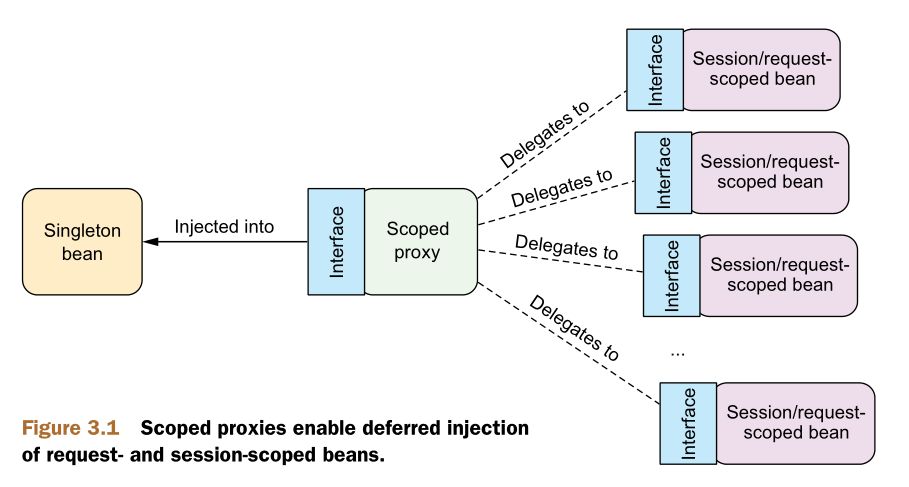一、
Spring的bean默认是单例的
But sometimes you may find yourself working with a mutable class that does main-
tain some state and therefore isn’t safe for reuse. In that case, declaring the class as a
singleton bean probably isn’t a good idea because that object can be tainted and cre-
ate unexpected problems when reused later.
Spring defines several scopes under which a bean can be created, including the
following:
Singleton—One instance of the bean is created for the entire application.
Prototype—One instance of the bean is created every time the bean is injected
into or retrieved from the Spring application context.
Session—In a web application, one instance of the bean is created for each session.
Request—In a web application, one instance of the bean is created for each request.
二、@Scope的三种用法
1.在自动扫描中
1 @Component 2 @Scope(ConfigurableBeanFactory.SCOPE_PROTOTYPE) 3 public class Notepad { ... }
2.在java配置文件中
@Bean @Scope(ConfigurableBeanFactory.SCOPE_PROTOTYPE) public Notepad notepad() { return new Notepad(); } ww
3.在xml配置文件中
<bean id="notepad" class="com.myapp.Notepad" scope="prototype" />
三、
若不指明proxyMode,当把一个session或request的bean注入到sigleton的bean时,会出现问题。如把购物车bean注入到service bean
1 @Component 2 @Scope( 3 value = WebApplicationContext.SCOPE_SESSION, 4 proxyMode = ScopedProxyMode.INTERFACES) 5 public ShoppingCart cart() {... }
@Component public class StoreService { @Autowired public void setShoppingCart(ShoppingCart shoppingCart) { this.shoppingCart = shoppingCart; } ... }
因为StoreService是signleton,是在容器启动就会创建,而shoppingcart是session,只有用户访问时才会创建,所以当StoreService企图要注入shoppingcart时,很有可能shoppingcart还没创建。spring用代理解决这个问题,当ShoppingCart是接口时,指定 ScopedProxyMode.INTERFACES。当ShoppingCart是一个类时,则指定ScopedProxy- Mode.TARGET_CLASS,srping会通过CGLib来创建基于类的代理对象。当request注入到signleton bean时,也是一样。

在xml中声明proxy策略
1 <?xml version="1.0" encoding="UTF-8"?> 2 <beans xmlns="http://www.springframework.org/schema/beans" xmlns:xsi="http://www.w3.org/2001/XMLSchema-instance" xmlns:aop="http://www.springframework.org/schema/aop" xsi:schemaLocation=" 3 http://www.springframework.org/schema/aop 4 http://www.springframework.org/schema/aop/spring-aop.xsd 5 http://www.springframework.org/schema/beans 6 http://www.springframework.org/schema/beans/spring-beans.xsd"> 7 8 <bean id="cart" class="com.myapp.ShoppingCart" scope="session"> 9 <aop:scoped-proxy /> 10 </bean> 11 </beans>
<aop:scoped-proxy> is the Spring XML configuration’s counterpart to the @Scope
annotation’s proxyMode attribute. It tells Spring to create a scoped proxy for the bean.
By default, it uses CGL ib to create a target class proxy. But you can ask it to generate an
interface-based proxy by setting the proxy-target-class attribute to false :
<bean id="cart" class="com.myapp.ShoppingCart" scope="session"> <aop:scoped-proxy proxy-target-class="false" /> </bean>